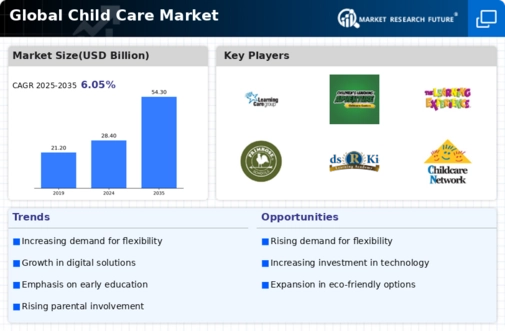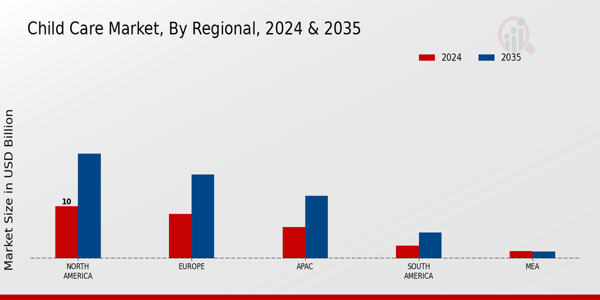Child Care Size
Child Care Market Growth Projections and Opportunities
In 2022, the child care market was estimated to be worth USD 202.9 billion. Over the forecast period (2023 - 2032), the child care market industry is expected to increase at a compound annual growth rate (CAGR) of 5.60%, from USD 214.2 billion in 2023 to USD 331.3 billion by 2032. Government programs, women's employment, and an emphasis on early childhood education are the main factors propelling the market's expansion.
The child care market is influenced by a range of factors that collectively shape its dynamics and responsiveness to the needs of parents and caregivers. One significant factor is demographic trends, such as changes in family structures and the increasing number of dual-income households. As more parents join the workforce, there is a growing demand for child care services to support families in balancing work and family responsibilities. This has led to an expansion of the child care market, with various providers offering a range of options, including daycare centers, in-home care, and after-school programs.
Economic factors also play a crucial role in the child care market. The affordability and accessibility of child care services are key considerations for parents. Government subsidies, tax credits, and employer-sponsored child care programs can influence the affordability of child care and impact the decisions parents make regarding the type of care they choose for their children. Economic downturns may result in cost-cutting measures for families, impacting their choices and reliance on child care services.
Government regulations and policies are significant market factors in the child care industry. Licensing requirements, safety standards, and staffing ratios are crucial considerations that shape the operations and offerings of child care providers. Changes in regulations can impact the cost of providing child care services and influence the overall market landscape. Additionally, government initiatives to improve the quality and accessibility of child care services can have a positive effect on the market, promoting the well-being and development of children in care.
Cultural and social trends contribute to the evolving nature of the child care market. Shifts in parenting philosophies, such as an increased emphasis on early childhood education and developmental milestones, influence the demand for child care services that align with these values. Moreover, societal attitudes towards gender roles and the involvement of fathers in childcare contribute to the diversification of child care arrangements, with more fathers actively participating in the decision-making process and seeking child care options that suit their family dynamics.
Technological advancements have also impacted the child care market. The use of digital platforms and mobile apps for communication between parents and child care providers, as well as for monitoring children's activities, has become more prevalent. Technological solutions not only enhance the efficiency of child care operations but also provide parents with real-time updates and a sense of security about their child's well-being.
The availability of skilled and qualified child care professionals is a critical factor in the market. Staffing shortages, high turnover rates, and the qualifications of child care providers can affect the quality and reliability of child care services. Providers that invest in training, competitive wages, and creating a positive work environment are better positioned to attract and retain qualified staff, ultimately contributing to the overall quality of child care offerings.
Consumer preferences and the demand for flexible child care options are additional market factors. Parents seek child care services that cater to their specific needs, including flexible hours, part-time options, and drop-in services. Providers that adapt to these preferences by offering customizable solutions can gain a competitive edge in the market.











Leave a Comment